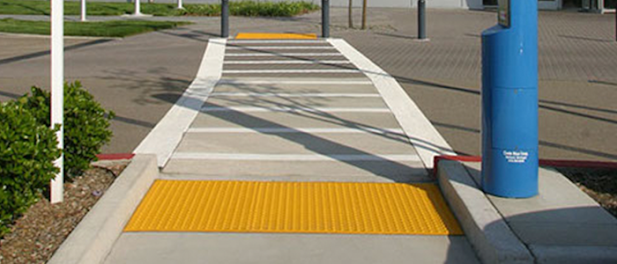ADA Detectable Warning Tiles- A Comprehensive Guide
ADA detectable warning tiles, also known as truncated dome tiles, are tactile surfaces that provide a warning to people with visual impairments of changes in their environment. These tiles are typically placed at the intersection of pedestrian walkways and hazardous vehicular areas, such as sidewalks and crosswalks. They can also be used to mark other hazardous areas, such as stairs, elevators, and construction zones.
ADA detectable warning tiles must meet certain specifications in order to be considered compliant with the Americans with Disabilities Act (ADA). These specifications include:
- The tiles must have a truncated dome pattern with a diameter of 0.9 inches and a height of 0.2 inches.
- The tiles must be made of a durable material that is resistant to wear and tear.
- The tiles must be contrasting in color to the surrounding surface so that they are easy to see.
- The tiles must be flush with the surrounding surface so that they do not pose a tripping hazard.
There are two main types of ADA detectable warning tiles: cast-in-place tiles and surface-applied tiles. Cast-in-place tiles are embedded in concrete during the construction process. Surface-applied tiles can be bonded to existing concrete surfaces.
Benefits of ADA Detectable Warning Tiles
ADA detectable warning tiles provide a number of benefits for people with visual impairments, including:
- Safety: ADA detectable warning tiles can help to prevent accidents by alerting people with visual impairments to hazardous areas.
- Independence: ADA detectable warning tiles can help people with visual impairments to navigate their environment independently.
- Accessibility: ADA detectable warning tiles can make public and private spaces more accessible to people with visual impairments.
Applications of ADA Detectable Warning Tiles
ADA detectable warning tiles can be used in a variety of applications, including:
- Pedestrian walkways: ADA detectable warning tiles are typically placed at the intersection of pedestrian walkways and hazardous vehicular areas, such as sidewalks and crosswalks.
- Stairs and elevators: ADA detectable warning tiles can be used to mark the top and bottom of stairs, as well as the entrance and exit to elevators.
- Construction zones: ADA detectable warning tiles can be used to mark hazardous areas in construction zones, such as open trenches and exposed wires.
- Public and private spaces: ADA detectable warning tiles can be used in a variety of public and private spaces, such as sidewalks, streets, parks, shopping malls, and office buildings.
How to Choose ADA Detectable Warning Tiles
When choosing ADA detectable warning tiles, it is important to consider the following factors:
- Type of application: Choose the type of tile that is best suited for the application, such as cast-in-place tiles for new construction and surface-applied tiles for retrofit projects.
- Material: Choose a tile that is made of a durable material that is resistant to wear and tear.
- Color: Choose a tile that is contrasting in color to the surrounding surface so that it is easy to see.
- Compliance: Make sure that the tiles you choose meet all applicable ADA requirements.
Conclusion
ADA detectable warning tiles are an important safety feature for people with visual impairments. They can help to prevent accidents, promote independence, and make public and private spaces more accessible. When choosing ADA detectable warning tiles, it is important to consider the type of application, material, color, and compliance.




Comments
Post a Comment